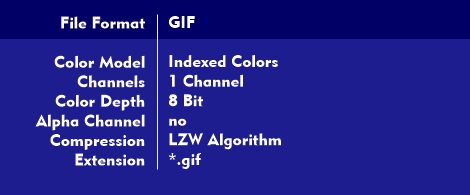graphics interchange format (file format) (GIF)
Graphics Interchange Format (GIF) is a graphics file format with lossless compression for the exchange of image data. The GIF format is interesting because it is hardware and platform independent. GIF is used to store and transfer pixel graphics and is supported by all web browsers and many graphics programs.
A GIF graphic consists of a large number of pixels, each of which is assigned its own color value. The color value results from the proportion of red, green, blue( RGB) whereby each pixel has a color depth of 8 bits, which corresponds to a color resolution of 256 colors. The position of each pixel does not need to be specified explicitly because it is stored line by line from top left to bottom right. GIF works with compression and uses the LZW algorithm (LZW).
The Graphics Interchange Format comes in two versions: GIF87a and GIF89a, where version 89a differs from other image file formats in that transparent images can also be defined as in Portable Network Graphics( PNG), that the files also contain ASCII text, and that GIF files can be created with small 2D animations. The 2D animations can be created with Animated GIF from a sequence of individual images. Sequences of Animated GIF are very common on the Internet as animated banners, because they can be rendered by almost all web browsers and have smaller data sizes than Javaapplets.
The call of a GIF file is relatively fast in the interlacing, i.e. in a gradual structure of the picture. The file extension for GIF files is *.gif.

